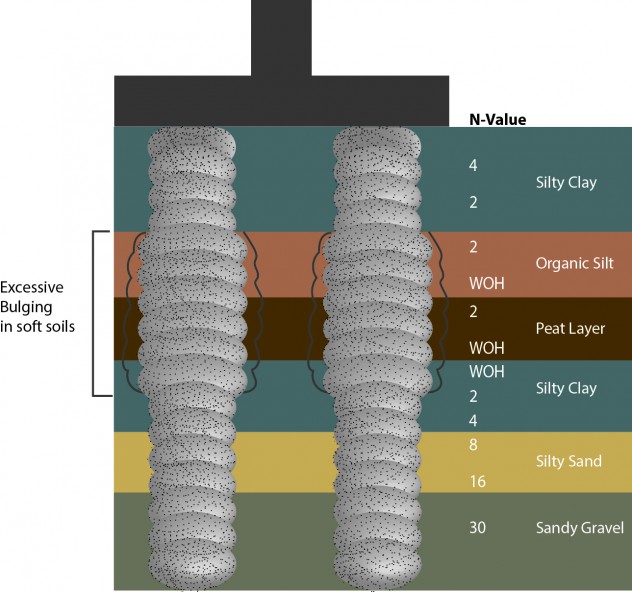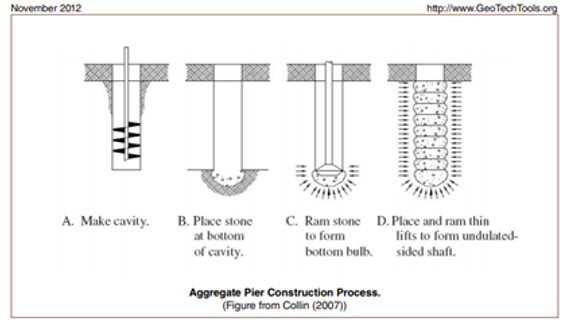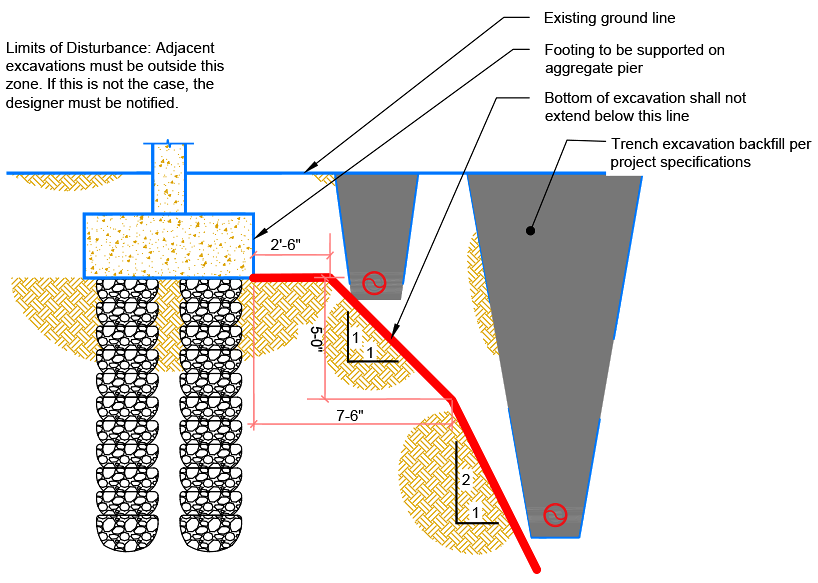This system allows for standard spread footing and slab-on-grade design and provides for better capacity in poorer soils. Treat up to 16m depths.

Pdf Rammed Aggregate Pier Design And Construction In California Performance Constructability And Economics Semantic Scholar
The instal-lation of RAPs beneath strip footings provides for stiffer support at the pier locations resulting in a non-uniform.

. Single-slope pier protection shall be provided where piers are accessible to errant vehicles and within 30 feet of the traveled way. The installation process imparts significant lateral. The Geopier X1 installation process consists of drilling out unsuitable soils to a desired design depth and then constructing a dense column of aggregate using a patented tamper.
Custom built to your needs. V ibro piers also known as aggregate piers are typically in stalled to intermediate depths of 5 to 20 feet for the support of new loads. Design shall rely on subsurface information presented in the project geotechnical report.
Aggregate pier installation is a ground improvement technique that constructs dense columns of compacted stone. Roadway the design of the pierpier protection must meet the requirements of Section 3651 Protection of Structures in the current NYSDOT LRFD Bridge Design Specifications. Typical Process Aggregate pier systems are fairly simple in nature to install.
The pier is constructed in 3-foot-thick lifts using well-graded aggregate open-graded aggregate or sand. Suited for light to heavy loads on large or small projects vibro piers are quick to install and very effective at reinforc ing the surrounding soil. ASCE Special Publication No.
Aggregate Piers Filling the Gap. Results of field and laboratory tests performed to evaluate the shear strength of the rammed aggregate pier elements 2. The Rammed Aggregate Pier elements shall be designed using a Rammed Aggregate Pier stiffness modulus to be verified by the results of the modulus test described in Section 502.
Although Terrapiers are similar to other aggregate columns such as the Geopier Rammed Aggregate Pier a vastly improved design methodology has been developed. Aggregate piers often work best with soils that contain soft clays silts or man-made fills. Terrapiers are rammed aggregate columns acting as structural elements designed to reinforce a compressible soil mass allowing shallow foundation support with minimal settlement.
Provision of all equipment material labor and supervision to design and install aggregate pier elements. Aggregate piers are constructed by predrilling an open hole to the treatment depth backfilling with rock and compacting it in lifts with a specialty Vibro-Probe or compaction equipment. Rammed Aggregate Pier RAP soil reinforcing elements.
Essentially by using a rammed aggregate pier system to increase the existing soils bearing capacity the structural engineer can design a shallow footing system that would typically be used for a site with preferred soil conditions. The process allows for construction flexibility and the ability to construct through caving zones that are encountered during drilling operations. Ad The Leading Online Publisher of National and State-specific Legal Documents.
Typical construction begins with pre-drilling the pier location to create a full-depth hole with a. Principals in our firm are licensed Geotechnical engineers with extensive prior experience in Geotechnical analysis and design including 25 years of designbuild experience of the Geopier Rammed Aggregate Pier. The uncertainties involved in the current design of footings supported by rammed aggregate piers RAPs have brought about the need to analyze the complete foundation system accurately using the.
Aggregate piers referenced in these specifications refer to both vibro stone columns and rammed piers. Our company specializes in the design and construction of the GeoRam Design Engineered Aggregate Pier EAP and. GROUND IMPROVEMENT WITH RAMMED AGGREGATE PIERS RAPs Design Consideration At the preliminary design stage the elastic and consolidation compression response of the site under loads to be imposed by the structures is assessed by using Settle 3D RocScience software which enabled 3D settlement analysis.
Design Submittal The Installer shall submit detailed design calculations construction drawings and shop drawings the Design Submittal for review and approval at. Rammed Aggregate Piers Defeat 75-Foot Long Driven Piles Proceedings Performance Confirmation of Constructed Geotechnical Facilities. GeoBase Dynamic Subgrade Improvement.
Geopier Grouted Rammed Aggregate Pier elements are built similarly to Geopier Impact with a grout mixture added to provide for high capacity Geopier elements in highly organic or very softloose soils. The idea of aggregate piers was initially conceived in 1988 as an effort to make stone replacement more efficient and easily implementable at a larger scale. The Geopier X1 system creates Rammed Aggregate Pier RAP elements using a vertical ramming process which is a combination of both replacement and displacement methods.
The processes to design and construct aggregate piers have since evolved by quantum leaps making aggregate piers a reliable and widely-accepted ground. Aggregate piers are compacted stone columns used to reinforce silt clay and variable fill material. The columns are installed in groups in soft soil to increase bearing pressure and mitigate settlement under structural footings.
Descriptions of project conditions and design approaches used for two projects in the United. Top-of-Rammed Aggregate Pier Stress kPa deflection mm North AbutmentSouth Abutment South Ramp South Ramp II North Ramp Design Stress 18000 psf ¾-in top vertical deflection. In soil profiles where the predrilled hole may collapse.
Side grooves for easy accessory attachment. Instant Download Mail Paper Copy or Hard Copy Delivery Start and Order Now. Ad Install remove by yourself.
Geotechnical Instrumentation Layout Near the Bridge Abutments at general locations of higher bearing pressure. Conventional strip footings supported at grade are traditionally designed assuming that the subgrade soils beneath the footings provide uniform support. Design methods implemented to evaluate the effectiveness of soil stabilization with rammed aggregate pier elements and 3.

Pdf Rammed Aggregate Pier Design And Construction In California Performance Constructability And Economics Semantic Scholar

Aggregate Piers Ground Improvement Techniques Subsurface Constructors

Pdf Rammed Aggregate Pier Design And Construction In California Performance Constructability And Economics Semantic Scholar

Rammed Aggregate Pier Construction Process Download Scientific Diagram



0 comments
Post a Comment